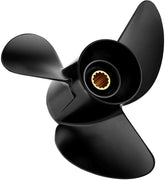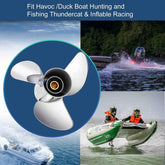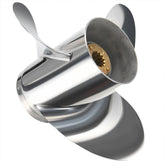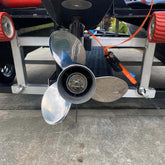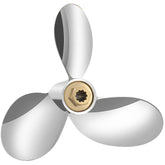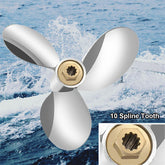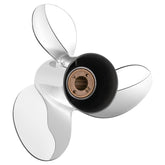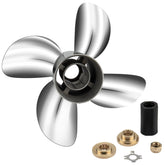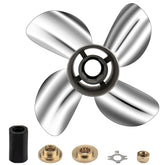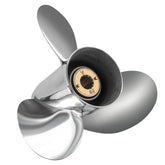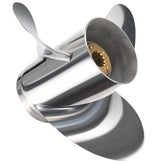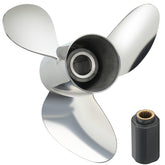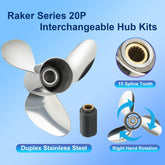Yamaha Boat Propeller Guide — How to Choose a Replacement That Fits Mercury, Honda and Volvo Outboards
If you want a propeller that performs exactly as you expect—without surprises—you need the facts, not opinion. Below is a practical, engineer-level guide for replacing a Yamaha propeller and ensuring the replacement will work on Mercury, Honda or Volvo lower units. I’m writing as a propeller engineer: no marketing fluff, just the steps and the tradeoffs you must understand before you buy from a catalog or fit a competitor blade.
Why this matters
A propeller change affects acceleration, top speed, fuel consumption, vibration and drivetrain life. The mechanical fit (spline/hub) is as important as diameter × pitch. Get the fit and test procedure right and you’ll get reliable performance; skip it and you risk poor performance or damage.
VIF in one line: engineering + production
VIF designs and manufactures aluminum and stainless propellers and supplies matched hardware and water-pump repair kits. We can produce direct-fit propellers for Yamaha, Mercury, Honda, Suzuki, Tohatsu, Johnson and Evinrude—and we custom-engineer Volvo fits on demand. That capability removes the common compromises of adapters and “close enough” replacements.
Step 1 — Collect three decisive data points (do this first)
Before you order anything, gather and photograph these items. They answer most fit questions.
-
Prop stamp: diameter × pitch (e.g.,
13 x 19) — usually stamped on the hub or blade. -
Hub / spline: photograph the prop hub interior and the lower-unit input shaft. If you can read a parts number for the hub or lower unit, note it.
-
Engine ID & current WOT rpm: engine brand/model/year/serial and a recorded wide-open-throttle RPM with the current prop installed, under a typical load (people + gear).
Also note blade count and material (3/4/5 blades; aluminum or stainless), boat type, typical load and mission (cruise, tow, fishing, performance). Send photos—clear hub and shaft pictures answer about 80% of fit problems instantly.
Step 2 — Hub and spline: the mechanical gatekeeper
If spline profile or spline count doesn’t match, the prop won’t fit securely. Three practical approaches when mixing brands:
-
Direct fit: ideal — same spline/profile and clearance. Fit and test WOT rpm.
-
Hub swap (OEM hub kit): replace the hub to match the target lower unit. Works only if the prop body and hub are designed for replacement.
-
Custom prop with correct spline: most robust — prop manufactured with the exact spline profile for your lower unit.
Avoid generic adapters unless you understand the tradeoffs: adapters can introduce axial and radial offsets, change torque transmission and create long-term wear or vibration issues.
Step 3 — Diameter × pitch: use RPM to tune, not guess
The correct way to evaluate pitch/diameter changes is by measuring WOT RPM:
-
Record baseline WOT RPM with current prop and load.
-
Compare to the engine manufacturer’s recommended WOT band for your model (check the manual).
-
Interpretation:
-
If WOT RPM is above the recommended band → prop is too small / pitch too low. Increase pitch or diameter.
-
If WOT RPM is below the band → prop is too large / pitch too high. Reduce pitch or diameter.
-
Make changes in small steps (about ±1–2 inches of pitch) and re-test under the same load. This iterative, data-driven approach finds the best compromise between acceleration and top speed without overstressing the engine.
Step 4 — Material & blade count: match to the mission
-
Aluminum: cost effective, repairable after light impacts; good for most recreational use.
-
Stainless steel: thinner, stronger, more efficient at high rpm; preferred for high-output engines and performance use.
-
Blade count: 3-blade = balanced; 4-blade = stronger low-end thrust and better loaded performance (useful for towing or heavy loads); 5-blade = niche, for extreme stability or towing.
Choose material and blade count based on power, desired behavior (better hole shot vs higher top speed), and how often you expect to hit submerged objects.
Step 5 — Installation & verification checklist
-
Inspect splines, hub rubber and shaft for wear before installation.
-
Use the correct prop nut, washer and cotter pin. VIF supplies matched propeller hardware kits to avoid mismatched fasteners.
-
Run the boat at idle to check rubbing or cavitation; then bring to WOT and record rpm. Log trim setting and load.
-
If vibration appears, stop and inspect hub, shaft runout and blade straightness—don’t proceed blindly.
Common fault patterns & what to check
-
New vibration but blades look fine: check hub rubber, spline wear and shaft runout.
-
Lower top speed with higher fuel burn: likely pitch mismatch or damaged blades.
-
Slippage under load: worn hub or incorrect hub fit—replace hub or use a true direct-fit prop.
Three pragmatic cross-brand rules
-
If you want long-term reliability and you operate frequently or under heavy loads, choose a custom prop with the correct spline.
-
If you must reuse a competitor prop, insist on an OEM hub swap (not a cheap adapter).
-
If performance margin is critical (racing, towing), choose stainless and validate WOT rpm after each change.
How VIF makes this simple for you
Send us: engine make/model/serial, prop stamp photo, hub & lower unit photos, boat type and typical load. VIF will provide three engineer-rated options: direct fit (if possible), hub swap kit (if applicable) and a custom prop option with expected WOT rpm change and hardware list. We also include compatible water pump repair kits and prop hardware kits when you order to make installation straightforward.
Order checklist — what to include on vifprop.com
When placing an order or request on vifprop.com/order, include:
-
Engine brand/model/year/serial
-
Photos: prop stamp, hub interior, lower unit input shaft
-
Current WOT RPM and typical load (people + gear)
-
Desired outcome (better acceleration, higher top speed, towing performance)
-
Delivery country and contact info
Final note (practical, not promotional)
A correctly chosen propeller is an engineering decision: it requires the hub/spline fit plus a short test cycle to validate RPM and behavior. If you want a worry-free replacement that fits Yamaha and also runs perfectly on Mercury, Honda or Volvo lower units, the robust path is a prop manufactured with the correct spline and tuned pitch—not an off-the-shelf guess.
Ready to get your replacement? Buy a boat propeller on the VIF.


